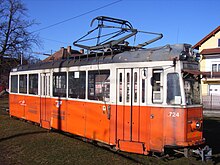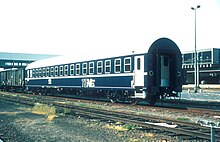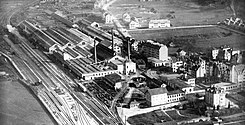Schweizerische Wagons- und Aufzügefabrik AG Schlieren-Zurich
| Schweizerische Wagons- und Aufzügefabrik AG Schlieren-Zurich
|
|
|---|---|
| legal form | Corporation |
| founding | May 18, 1895 |
| resolution | August 31, 1985 |
| Reason for dissolution | Closure of production |
| Seat |
Schlieren , Switzerland |
| Number of employees | 1,100 |
| sales | 11.5 million CHF |
| Branch | Rail vehicles , elevator systems |
| Status: 1949 | |


The Schweizerische Wagons- und Aufzügefabrik AG, Schlieren-Zurich ( SWS , locally and colloquially “Wagi” ) was a Swiss manufacturer of rail vehicles and elevator systems based in Schlieren in the canton of Zurich .
history
The company was founded in 1895 with the company Geissberger & Cie. who opened a car factory at Schlieren station . In 1899 Geissberger became the Schweizerische Wagen- und Wagons-Fabrik AG with headquarters in Zurich , with the headquarters being relocated to Schlieren just one year later. In 1901 the name was changed to Schweizerische Wagonsfabrik AG in Schlieren-Zurich . In 1903 the newly founded Swiss Federal Railways (SBB) ordered passenger cars from SWS , in 1906 the 1,000th railroad car left the factory and in 1909 the 2,000th car was delivered to the SBB. At that time also were tram - cars , partly together with the Maschinenfabrik Oerlikon produced. Among them, for example, the widespread Swiss standard car . In 1923, in cooperation with BBC, two class 1020 locomotives were delivered to Japan - a rarity because the factory was hardly involved in locomotive construction. In 1917 the elevator business of the Seebach AG elevator and wheel factory was taken over and in 1928 the name of the company was changed to Schweizerische Wagons- und Aufzügefabrik AG, Schlieren-Zurich .
In 1932, the SBB's train transport and workshop service commissioned a study for a series of new passenger coaches with reduced weight compared to the heavy steel wagons that weighed 40 to 45 t and a 5 km / h higher cornering speed with the same or improved comfort the Swiss wagon and elevator factory Schlieren. With the order, a basic concept was presented by the upper machine engineer of the Swiss Federal Railways , Walter Müller, and his section head for wagon construction, Fritz Halm. They were able to convince the SWS, in particular the technical director Karl Füchslin and the chief designer Robert Müller, with their idea. Karl Füchslin carried out the static calculations, which was time-consuming work at the time. Robert Müller was the designer. The first light steel car (SBB) was built in Schlieren .
Another milestone followed in the first post-war years. Thanks to a cooperation agreement between the Indian State Railways and the group management in Schlieren, a major order was realized in India in 1949 under the then management of the SWS project manager Heinrich Saxer König. Schlieren played a key role in the planning and implementation of a new wagon factory in Perambur. In 1955 the Integral Coach Factory ICF started operations in India. The Indian State Railways ordered around 200 passenger coaches in Schlieren in advance .
In 1952 Schlieren brought the Variotron drive for elevators onto the market. It was the world's first electronically regulated elevator. This system accelerated and decelerated the movement of the elevator steplessly and controlled the speed according to a precisely prescribed program.
In the years 1957 to 1958 two important events occurred. In 1957 Schlieren delivered the Monotron elevator control for the first time. Monotron can be seen as a landmark in elevator construction. At the same time, it was an initial success of joint research by Schindler and Schlieren. Still based on the Variotron control, Schlieren delivered a high-speed passenger elevator in 1958 for the Atomium in Brussels, which was built for the Expo 58 world exhibition . It was the fastest elevator in the world at the time with a speed of (5 m / s).
Takeover by Schindler
In 1956 it became known that Pars Finanz AG - the parent company of the Schindler Group, which was active in elevator and wagon construction - had bought 30% of the share capital. At the meeting, it was also decided to convert the previous bearer shares into registered shares . The share capital was increased from 6 million Swiss francs to 7.5 million Swiss francs. "Wagi" was completely taken over in 1960 and integrated into the Schindler Group as a group company. When Swiss rail vehicle construction was restructured in 1980/1981, SWS specialized in component production as well as conversions and revisions, in elevator construction on standard doors and cabins.
Closure
In 1983 Schindler announced that the SWS would be closed; At the end of August 1985, the "Wagi" was closed amid loud protests from workers and the population. On the factory site, which was leveled within a very short time, a large new building was built for a printing plant for the Neue Zürcher Zeitung (NZZ); New small businesses in particular settled in other new buildings.
Historical legacy
For years, Thomas Stauber and Georges Peier have been collecting documents such as diagrams, technical drawings, brochures, employee newspapers and items that originated from the manufacture of the “Wagi” at the time. In 2007 they jointly founded IG Historic Schlieren , which is affiliated with the Schlieren Local History Association (VHS). In 2016 the IG was converted into an association . The WAGI Museum Schlieren was opened in September 2017 .
literature
- Adalbert Stäger: 40 years of car manufacturing. 10,000 rail vehicles. 1901-1941. Swiss Wagons- u. Elevator factory, 1941.
- Fifty years of Schweizerische Wagons- und Aufzügefabrik AG Schlieren-Zurich 1899–1949. Orell Füssli, Zurich 1950.
- Georges Baumgartner, Urs Stolz: The history of the Schlieren D'WAGI wagon and elevator factory 1895–1985.
Web links
- Museum Schweizerische Wagons- und Aufzügefabrik AG Schlieren: Wagi Museum Schlieren. Accessed January 7, 2018 (German).
- Image database of the Swiss Society for Railway History SGEG. Retrieved on January 7, 2018 (German, image database with partial SWS photo archive).
- Reto Weiss: Swiss wagon and elevator factory (SWS). In: Historical Lexicon of Switzerland .
- Wagi Museum Schlieren. In: YouTube. Retrieved January 7, 2018 .
Individual evidence
- ↑ Florian Niedermann: "Wagi scrap" collected from all over the world . In: az Limmattaler Zeitung . November 1, 2012 ( limmattalerzeitung.ch [accessed January 7, 2018]).
- ↑ Stefan Nidegger: The Schlieren wagon factory lives on . In: az Aargauer Zeitung . ( aargauerzeitung.ch [accessed on January 7, 2018]).
- ↑ Stefan Nidegger: A homage to the Schlieren wagon factory . In: az Limmattaler Zeitung . ( limmattalerzeitung.ch [accessed on January 7, 2018]).








